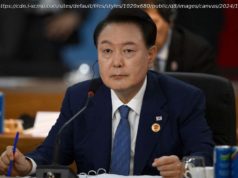The world might protest, but ultimately countries have to deal with the U. S.
President Trump hailed Monday a last-minute agreement with Canada that would, in effect, rebrand the North American Free Trade Agreement. He called the pact, which also includes Mexico, “a great deal for all three countries [that] solves the many deficiencies and mistakes in NAFTA.”
The new agreement, which was announced late Sunday, is being labeled the United States Mexico Canada Agreement, or USMCA, and it ends months of uncertainty over what Trump’s longtime aversion to NAFTA would mean for the accord, which went into effect in 1994.
Renegotiating NAFTA was a key campaign promise for the U. S. president because, in his view, the agreement hurt U. S. workers. Last month, the U. S. reached what Trump called a bilateral trade agreement with Mexico, but a similar pact with Canada proved trickier. Negotiations between the two sides were at an impasse over access to Canada’s highly protected dairy sector, Canadian auto imports to the U. S., and how trade disputes are settled. Further details are expected Tuesday; on Monday, different observers had different assessments of the significance of the changes—from modest to significant. If nothing else, the agreement gives Trump a political win.
Trump’s NAFTA strategy: b luff, rebrand, and declare victory
Among the most significant changes: U. S. dairy farmers will have marginally more access to Canada’s market, a win for the U. S.; the mechanism used to resolve trade disputes is being preserved, despite strong U. S. opposition to it; Canadian and Mexican auto imports will have some exemptions from U. S. auto tariffs; and the new trade agreement will have a sunset clause—16 years, up from the five years the U. S. had demanded. The agreement must be approved by the legislatures in all three countries, which is by no means assured. Until then, NAFTA remains in place.
The new agreement shows not only how Trump is willing to risk alliances to get the kinds of agreements he believes benefits American workers, but also how, despite protests, U. S. partners have little choice but to go along with much of what the world’s largest economy wants. It also shows how, ultimately, Trump is starting to refashion the Western global order, which the U. S. constructed in the wake of World War II, to align with his own worldview: more transactional, more bilateral, and less reliant on permanent alliances.
Take Sunday’s trade agreement: U. S.-Canadian relations were hurt by the impasse as Trump, who is deeply unpopular in Canada, imposed steel and aluminum tariffs on Canadian imports (which don’t appear to have been lifted under the new agreement); called Trudeau “meek and mild,” “dishonest & weak”; and said he rejected Trudeau’s request for a meeting at the UN General Assembly (the Canadian leader denied he sought a meeting with Trump). For the first time ever, a majority of Canadians hold an unfavorable view of the U. S., which is not only a NATO ally, but also the country’s number-one trading partner. Indeed, the Canadian Chamber of Commerce, in a statement following the announcement of the trade agreement late Sunday, said it was “delighted,” but added: “Canada must remember the lesson this turbulent period has provided: We must never again allow ourselves to be overly-dependent upon one trading partner.”
Read how Trudeau reached his breaking point with Trum p
While this statement will no doubt be pounced upon by Trump’s critics as indicative of how the president alienates America’s allies and trading partners, the fact remains the U. S., Canada, and Mexico have a deal that succeeds NAFTA. There are other examples of this strategy: One of Trump’s first acts as president was withdraw the United States from the Trans Pacific Partnership trade agreement, which included the region’s largest economies and was viewed as a counterweight to China’s growing influence in the region. The pact’s remaining members are staying in the accord, hoping the U. S. eventually rejoins. But since the withdrawal, the U. S. has signed bilateral free-trade agreements with South Korea and Japan, both of which would rather deal with Trump than a resurgent China whom they fear. Trump has also said the U. K., which is negotiating a divorce settlement with the European Union prompted by Brexit, will have a preferential free-trade agreement with the U. S., and he has added that India has sought a bilateral free trade agreement as well. Neither of these deals may ultimately materialize, but their very discussion shows just how much the world still needs the United States, not to mention the president’s good graces, to survive.
Simply put, many countries are happier to accept Pax Americana than they are accepting a Chinese or Russian version of a global order. This approach does have a flip side, however: While America’s closest allies recognize they can’t survive without it, they’re not necessarily happy. After clashing over Trump’s withdrawal from the Paris climate accord, his criticism of NATO, his withdrawal from the nuclear agreement with Iran, and his punitive tariffs on European steel and aluminum imports, Angela Merkel, the German chancellor, said: “We Europeans truly have to take our fate into our own hands—naturally in friendship with the United States of America, in friendship with Great Britain, as good neighbors with whoever, also with Russia and other countries. But we have to know that we Europeans must fight for our own future and destiny.”
Or to restate the message from the Canadian Chamber of Commerce: “We must never again allow ourselves to be overly-dependent upon one trading partner.”






